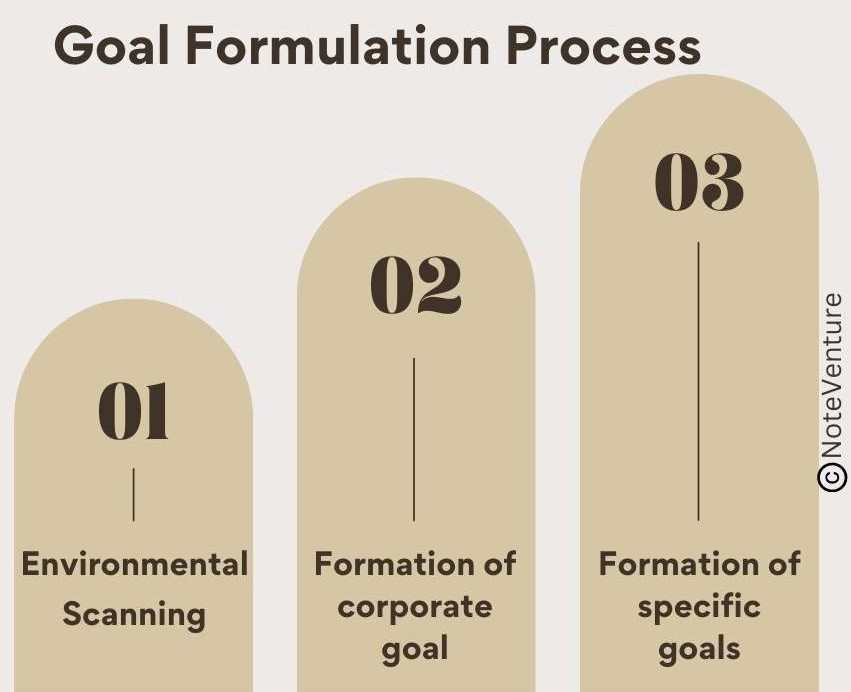1.3 Goal formulation: Processes and Approaches | Problems of Goal Formulation
… Hey there! Welcome to the third lesson of Unit 1. In this lesson, we will be covering Goal formulation: Processes and Approaches | Problems of Goal Formulation. As usual, I ask you to carefully study all these notes and think aloud or write down what you’ve learnt for effective memory. So, let’s get started.


हुन्छ Sir …..अब सुरु गरिहालौं!
Goal Formulation: Meaning
Meaning of Goal Formulation
Goal formulation (लक्ष्य निर्माण) is the process of creating clear targets that an organization wants to achieve. It helps the organization decide what it wants to do, what resources it needs, and how success will be measured.
The process starts with top-level management. They set the main goals of the organization. These are called corporate goals (संस्थागत लक्ष्य). After that, different departments and employees create their own goals to match the main goal. These are called specific goals (विशेष लक्ष्य).
All goals created in this process must follow the SMART rule —
They should be: Specific, Measurable, Acceptable, Realistic and Time-bound
This process helps the organization move in the right direction. It brings teamwork, helps in decision-making, and allows the organization to check if things are going well.
Goal Formulation: Processes
Process of Goal Formulation
To set effective goals, the organization should follow these steps:

1. Environmental Scanning
The first step of goal formulation is to study the environment. In this step, the organization studies both internal and external factors that affect goal setting.
- Internal factors are rules, resources, employees, and company culture
- External factors are politics, economy, technology, and society
To understand the situation better, organizations also use SWOT analysis, which means identifying Strengths (शक्ति), Weaknesses (कमजोरी), Opportunities (अवसर), and Threats (खतरा). This helps the organization understand its current position and future challenges.
2. Formation of Corporate Goal
The second step is the Formation of Corporate Goal. After analyzing the environment, top-level managers set the main goal of the organization. This is called the corporate or strategic goal. It reflects the overall purpose and direction of the organization. It answers questions like:
???? What is the organization trying to achieve?
???? What is its mission and vision?
3. Formation of Specific Goals
The third step is the Formation of Specific Goals (विशेष लक्ष्य बनाउने). Once the main corporate goal is ready, middle- and lower-level managers create more specific goals to support it. These include:
- Tactical goals – Medium-term goals to support the corporate goal
- Operational goals – Short-term goals for departments
- Individual goals – Goals set for each employee
These goals must match the corporate or the main goal so that everyone works in the same direction.
Summary
Goal formulation is the process of setting SMART goals from top to bottom.
It starts with a big plan and breaks it into smaller goals for each level.
Goal formulation: Approaches
Approaches to Goal Formulation
Goal formulation approaches (लक्ष्य निर्माणका तरिकाहरू) means the way managers take part in setting organizational goals.
Different organizations use different methods depending on how much they involve employees and managers at various levels. The main goal is to set goals that are clear, realistic, and achievable. There are three main approaches:
1. Top-Down Approach (माथिबाट तल)
In this approach, top-level managers set the goals for the entire organization. After the goals become final, they pass them down to lower-level managers and employees to implement.
This is a traditional approach, where only the top managers are involved in planning. The ideas and opinions of lower-level staff are not included. It may work fast but ignores the knowledge and ability of subordinates.
2. Bottom-Up Approach (तलबाट माथि)
In the bottom-up approach, middle and lower-level managers first prepare a draft of goals. These goals are then sent to top-level managers for approval.
This method is more participative and gives importance to the skills and experience of subordinates. The top-level managers can still make changes if necessary. It helps create commitment and better understanding among all levels.
3. Management by Objectives (MBO) (लक्ष्य अनुसारको व्यवस्थापन)
Management by Objectives (MBO) was introduced by Peter F. Drucker in 1954. In this approach, goals are created together through coordination between top, middle, and lower-level managers. Everyone understands what needs to be done, and there is teamwork and clarity.
The MBO process has four main steps:
- Setting goals together
- Making an action plan
- Reviewing performance
- Evaluating and rewarding
Employees are rewarded for achieving their goals. This makes them feel responsible and improves their performance.
Summary:
Top-down = Boss sets goal
Bottom-up = Staff suggest goal
MBO = Team sets goal together + reward system
Problems of Goal Formulation
Problems of Goal Formulation
Managers face different problems while setting goals in an organization. These problems make it difficult to create clear, realistic, and useful goals. Here are the common challenges:
1. Inappropriate Goals
Sometimes managers set goals that are too hard, too easy, or not related to the organization’s mission. These goals can confuse employees. They may feel demotivated or frustrated, and this can lead to failure in achieving the goals.
2. Improper Reward System
If the reward system is not fair, employees lose interest. When people work hard but don’t get proper rewards, they feel unmotivated and unrecognized. This makes it hard for managers to keep staff focused on the goal.
3. Dynamic and Complex Environment
The external environment keeps changing. Market trends, technology, laws, or customer behavior may shift suddenly. In such situations, it becomes hard to plan for the future. Managers struggle to set goals that will still be useful in a changing environment.
4. Resistance to Change
Some employees don’t like new plans or changes. They feel uncomfortable or afraid. This resistance makes it hard for managers to introduce new goals or update old ones. Without support from staff, goal-setting becomes a challenge.
5. Reluctance to Set Goals
Sometimes employees do not take part in setting goals. They may think it’s not important or they may not understand how to do it. This lack of interest creates problems for managers, as it reduces commitment and teamwork.
6. Resource Constraints
Managers often have limited resources like money, staff, or time. Without enough support, it becomes difficult to set or achieve goals. Managers must also choose which goals are more important because not everything can be done with limited resources.
Easy way to remember points of Problems of Goal formulation
Think of the word➔ Deeper,but to remember the real points, use ➔ DIP RRR.
DIP RRR stands for:
D – Dynamic and complex environment
I – Inappropriate goals
P – Poor reward system
R – Resistance to change
R – Reluctance to set goals
R – Resource constraints
Mini Quiz: Goal formulation: Processes, Approaches & Problems
Q1. What is the first step in the process of goal formulation?
Q2. Which approach does not include employees in setting goals?
Q3. What does SWOT stand for in goal formulation?
तपाईं अहिले TU Solution भन्ने tab मा हुनुहुन्छ
यहाँ तपाईंले यस chapter बाट अहिलेसम्म TU मा सोधिएका सबै question र त्यसको solution पाउनसक्नुहुन्छ। Question हरु chapter को topics अनुसार serially राखिएको छ।
Group A – Brief Answer Questions
Group A को लागि Chapterwise TU Solution
Goal Formulation: Processes and Approaches
Q) How are goals formulated?
→ Goals are formulated by following the steps given below:
1. Environmental Scanning
2. Formation of corporate goal
3. Formation of specific goals
Q) What are the approaches of goal formulation?
→ The approaches of goal formulation are:
1. Top- down approach
2. Bottom- up approach
3. Management by objectives (MBO)
Problems of Goal Formulation
Q) Mention three problems in goal formulation process. [TU Model Question 2022 Set 1 Q.No. 4]
→ The three problems in goal formulation process are:
1. Inappropriate goals – Goals may be too difficult or not linked to the mission.
2. Resistance to change – Employees may not support new plans or changes.
3. Lack of resources – There may not be enough money, time, or staff to achieve goals.
Q) State four problems of goal formulation. [2073 Q.No.1]
The four problems of goal formulation are:
- Inappropriate goals – Goals may be too difficult or not linked to the mission.
- Poor reward system – If rewards are unfair, employees lose motivation.
- Resistance to change – Some employees do not accept new goals or plans.
- Lack of resources – Managers may face shortage of staff, money, or time to achieve goals.
Group B – Descriptive Answer Questions
Group B को लागि Chapterwise TU Solution
Goal formulation: Processes and Approaches & Problems
Q) Explain the problems faced by managers during goal formation. [2073 Q.No.1]
Managers face different problems while setting goals in an organization. These problems make it difficult to create clear, realistic, and useful goals. Here are the common challenges:
- Inappropriate Goals
Sometimes managers set goals that are too hard, too easy, or not related to the organization’s mission. These goals can confuse employees. They may feel demotivated or frustrated, and this can lead to failure in achieving the goals.
- Improper Reward System
If the reward system is not fair, employees lose interest. When people work hard but don’t get proper rewards, they feel unmotivated and unrecognized. This makes it hard for managers to keep staff focused on the goal.
- Dynamic and Complex Environment
The external environment keeps changing. Market trends, technology, laws, or customer behavior may shift suddenly. In such situations, it becomes hard to plan for the future. Managers struggle to set goals that will still be useful in a changing environment.
- Resistance to Change
Some employees don’t like new plans or changes. They feel uncomfortable or afraid. This resistance makes it hard for managers to introduce new goals or update old ones. Without support from staff, goal-setting becomes a challenge.
- Reluctance to Set Goals
Sometimes employees do not take part in setting goals. They may think it’s not important or they may not understand how to do it. This lack of interest creates problems for managers, as it reduces commitment and teamwork.
- Resource Constraints
Managers often have limited resources like money, staff, or time. Without enough support, it becomes difficult to set or achieve goals. Managers must also choose which goals are more important because not everything can be done with limited resources.
Group C – Analytical Answer Questions
Group C को लागि Chapterwise TU Solution
